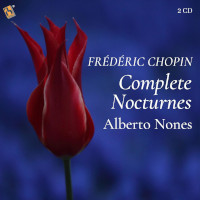Review by James Harrington
CHOPIN Nocturnes (Complete) • Alberto Nones (pn) • HALIDON 6905 (2 CDs: 110:51)
All of Chopin’s music involves the piano and is dominated by solo piano pieces with only a few involving other instruments, voice, or orchestra. Among the many genres of short pieces (under 10 minutes) Chopin excelled at is the nocturne. Although John Field is generally given credit for the first nocturnes, it was Chopin who brought the form to its peak.
Chopin published 18 nocturnes to which he assigned opus numbers during his lifetime. Those are the pieces included in this marvelous release. There are three nocturnes in both op. 9 and op. 15. All the other sets (opp. 27, 32, 37, 48, 55, and 62) contain two nocturnes each. These were composed 1830–46 and published 1832–46. Remembering that Chopin died at the age of 39 in 1849, and that his first composition was published in 1825, we can say that the nocturnes cover his creative life. By arranging these simply in opus number order, we can hear the development and maturation of Chopin’s style in the best light. Three early nocturnes (1826, 1830, 1837) were only published posthumously and are not included here. The E-Minor was assigned op. 72 and, despite it being often performed, would actually sound out of place at the end of the release, where it is typically placed in other collections, along with two other posthumous nocturnes.
Chopin’s own performances were noted for their nuance and sensitivity, and Nones follows admirably in that tradition. He shapes the melodies beautifully, and is very attentive to the inner voices. In choral music, we often refer to the alto and tenor parts as harmonic filler, and consider them less interesting than the soprano and bass. With Chopin, there are almost always secondary musical lines embedded in those inner parts. Nones uses wonderful dynamic shading that is normally reserved for the main melody for these inner lines, but never at the expense of the main melody. He brings out some that were new to me, while still providing a bass line that moves the music forward.
Chopin expressed annoyance in 1843 when Liszt performed one of his nocturnes with the addition of numerous intricate embellishments. Chopin remarked that Liszt should play the music as written or not play it at all, forcing an apology. Chopin would have been very pleased with Nones’s playing of the nocturnes. As the themes are repeated, Chopin himself provides plenty of both subtle and extensive embellishments. This recording is notable for Nones’s handling of all these melismatic phrases with just enough rubato to keep the pulse and still revel in Chopin’s ornamentation.
After listening to Nones’s disc of Chopin Fantasies (Convivium 074, Fanfare 46:2, Nov/Dec 2022), I remarked that they make you want more from this pianist. Nones plays his own 1975 Bösendorfer (the piano and pianist are the same age). The piano we hear on this wonderful-sounding disc has a clarity and depth not often heard or as well recorded. Nones also provides a fascinating booklet essay. Halidon has Nones’s 2016 recording of the complete Mazurkas now available for download, and here we have the Nocturnes. This pianist is on a very good roll with Chopin and I certainly look forward to more! James Harrington






















